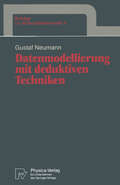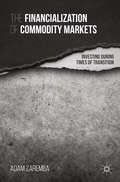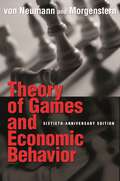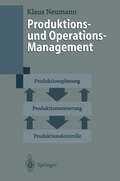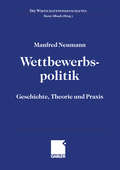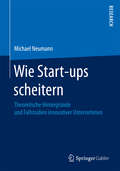- Table View
- List View
Datenmodellierung mit deduktiven Techniken (Beiträge zur Wirtschaftsinformatik #9)
by Gustaf NeumannBerücksichtigung strukturschwacher Verdichtungsgebiete in der regionalen Wirtschaftsförderung (Forschungsberichte des Landes Nordrhein-Westfalen #3157)
by Hannelore NeumannEinkommenssituation und Einkommensentwicklung in den strukturschwachen Verdichtungsgebieten Nordrhein-Westfalens — ein inner- und interregionaler Vergleich —: — Zum Informationsgehalt räumlicher Einkommensvergleiche für die regionale Wirtschaftspolitik und zu den Bestimmungsgründen regionaler Einkommensdisparitäten — (Forschungsberichte des Landes Nordrhein-Westfalen #2871)
by Hannelore NeumannFrauen in der öffentlichen Arbeitsmarkt- und Strukturpolitik (Forschungsberichte des Landes Nordrhein-Westfalen #3226)
by Hannelore NeumannPay-TV in Deutschland: Markteintritts- und Wettbewerbsbedingungen für neue Anbieter (Gabler Edition Wissenschaft)
by Ingo NeumannDer Autor stellt die medienökonomischen Grundlagen des Pay-TV und die institutionellen Rahmenbedingungen des Fernsehens in Deutschland dar, um darauf aufbauend die neue Form der Programmveranstaltung in den intermediären Wettbewerbszusammenhang einzuordnen.
The Financialization of Commodity Markets: Investing During Times of Transition
by Iver B. Neumann A. ZarembaThe landscape of commodity markets has drastically changed in recent years. Once a market of refineries and mines, it has become the market of investment funds and commodity trading advisors. Given this transformation, are commodity investments still as beneficial as 20 or 30 years ago? This book is an attempt to answer these questions.
Theory of Games and Economic Behavior
by John Von Neumann Oskar Morgenstern Harold William Kuhn Ariel RubinsteinThis is the classic work upon which modern-day game theory is based. What began more than sixty years ago as a modest proposal that a mathematician and an economist write a short paper together blossomed, in 1944, when Princeton University Press published Theory of Games and Economic Behavior. In it, John von Neumann and Oskar Morgenstern conceived a groundbreaking mathematical theory of economic and social organization, based on a theory of games of strategy. Not only would this revolutionize economics, but the entirely new field of scientific inquiry it yielded--game theory--has since been widely used to analyze a host of real-world phenomena from arms races to optimal policy choices of presidential candidates, from vaccination policy to major league baseball salary negotiations. And it is today established throughout both the social sciences and a wide range of other sciences. This sixtieth anniversary edition includes not only the original text but also an introduction by Harold Kuhn, an afterword by Ariel Rubinstein, and reviews and articles on the book that appeared at the time of its original publication in the New York Times, tthe American Economic Review, and a variety of other publications. Together, these writings provide readers a matchless opportunity to more fully appreciate a work whose influence will yet resound for generations to come.
Theory of Games and Economic Behavior
by John Von Neumann Oskar Morgenstern Harold William Kuhn Ariel RubinsteinThis is the classic work upon which modern-day game theory is based. What began more than sixty years ago as a modest proposal that a mathematician and an economist write a short paper together blossomed, in 1944, when Princeton University Press published Theory of Games and Economic Behavior. In it, John von Neumann and Oskar Morgenstern conceived a groundbreaking mathematical theory of economic and social organization, based on a theory of games of strategy. Not only would this revolutionize economics, but the entirely new field of scientific inquiry it yielded--game theory--has since been widely used to analyze a host of real-world phenomena from arms races to optimal policy choices of presidential candidates, from vaccination policy to major league baseball salary negotiations. And it is today established throughout both the social sciences and a wide range of other sciences. This sixtieth anniversary edition includes not only the original text but also an introduction by Harold Kuhn, an afterword by Ariel Rubinstein, and reviews and articles on the book that appeared at the time of its original publication in the New York Times, tthe American Economic Review, and a variety of other publications. Together, these writings provide readers a matchless opportunity to more fully appreciate a work whose influence will yet resound for generations to come.
GERT Networks and the Time-Oriented Evaluation of Projects (Lecture Notes in Economics and Mathematical Systems #172)
by K. Neumann U. SteinhardtTowards the end of the fifties methods for planning, scheduling,and control of proj ects were developed on the basis that the evolution of a project can be associated with a special weighted directed graph, called activity network. In this association, the individual activities of the project correspond to the arcs, the so-called proj ect events (beginning or termination of activities) correspond to the nodes, and the durations of the activities correspond to the weights of the respective arcs of the directed graph. 1) Contiguous arcs are assigned to activities which succeed one another immediately. The event corresponding to a node occurs exactly at the time at which all activities which are associated with the arcs leading into the node are terminated. After the occurrence of an event all those activities are be gun which correspond to the arcs emanating from the respective node. This implies especially that the evolution of the project has to be uniquely determined before hand, that every activity and every event are realized exactly once during the exe cution of the project, and that "feedback" (corresponding to cycles in the asso ciated network) is not permitted. Many projects, for example most R&D projects and projects in the area of production p 1 anni ng, do not sa ti sfy the foregoi ng res tri cti ons.
E-Energy: Wandel und Chance durch das Internet der Energie
by Karl-Heinz NeumannDie Liberalisierung der Energiemärkte schreitet weiter voran. Ohne den Einsatz von Informations- und Kommunikationstechniken (IKT) lassen sich die damit verbundenen Herausforderungen nicht meistern. In dem Band werden die vielfältigen Entwicklungen der IKT in der Energiewirtschaft von hochrangigen Experten diskutiert. Die Informations- und Kommunikationstechnologie eröffnet neue Möglichkeiten: bei erneuerbaren Energien und der Struktur der Energieerzeugung, bei Netzen, bei der Steuerung des Energieverbrauchs oder bei intelligenten Speichern.
Stochastic Project Networks: Temporal Analysis, Scheduling and Cost Minimization (Lecture Notes in Economics and Mathematical Systems #344)
by Klaus NeumannProject planning, scheduling, and control are regularly used in business and the service sector of an economy to accomplish outcomes with limited resources under critical time constraints. To aid in solving these problems, network-based planning methods have been developed that now exist in a wide variety of forms, cf. Elmaghraby (1977) and Moder et al. (1983). The so-called "classical" project networks, which are used in the network techniques CPM and PERT and which represent acyclic weighted directed graphs, are able to describe only projects whose evolution in time is uniquely specified in advance. Here every event of the project is realized exactly once during a single project execution and it is not possible to return to activities previously carried out (that is, no feedback is permitted). Many practical projects, however, do not meet those conditions. Consider, for example, a production process where some parts produced by a machine may be poorly manufactured. If an inspection shows that a part does not conform to certain specifications, it must be repaired or replaced by a new item. This means that we have to return to a preceding stage of the production process. In other words, there is feedback. Note that the result of the inspection is that a certain percentage of the parts tested do not conform. That is, there is a positive probability (strictly less than 1) that any part is defective.
Contributions to Operations Research: Proceedings of the Conference on Operations Research Held in Oberwolfach, West Germany February 26 – March 3, 1984 (Lecture Notes in Economics and Mathematical Systems #240)
by Klaus Neumann Diethard PallaschkeProject Scheduling with Time Windows and Scarce Resources: Temporal and Resource-Constrained Project Scheduling with Regular and Nonregular Objective Functions
by Klaus Neumann Christoph Schwindt Jürgen ZimmermannA survey of the state of the art of deterministic resource-constrained project scheduling with time windows. General temporal constraints and several different types of limited resources are considered. A large variety of time-based, financial, and resource-based objectives - important in practice - are studied. A thorough structural analysis of the feasible region of project scheduling problems and a classification and detailed investigation of objective functions are performed, which can be exploited for developing efficient exact and heuristic solution methods. New interesting applications of project scheduling to production and operations management as well as investment projects are discussed in the second edition.
Project Scheduling with Time Windows and Scarce Resources: Temporal and Resource-Constrained Project Scheduling with Regular and Nonregular Objective Functions (Lecture Notes in Economics and Mathematical Systems #508)
by Klaus Neumann Christoph Schwindt Jürgen ZimmermannA project is a unique undertaking or endeavor to be accomplished that can be divided into individual subtasks or activities each of which requires time and scarce resources for its completion. Also there is a desired objective to be attained (for example, minimization of project duration or of variation of resource utilization, or maximization of net present value of the project). Moreover, there are given precedence relationships among activities prescrib ing the order in which activities must be carried out. Project scheduling, in its basic form, consists of finding start times for all activities such that pre scribed resource and precedence constraints are satisfied and an objective function is optimized. Since the concept of a project can be interpreted quite broadly, project scheduling problems arise in a great variety of practical situations. These in clude construction work, the development and introduction of new products, service systems, or software packages, strategic long-term planning in manu facturing and the service sector, emergency planning, and even the conduct ing of political campaigns. Recently, project scheduling has been successfully applied to production and operations management, e.g. make-to-order pro duction in manufacturing and batch production in process industries. Since the late 1950's, network-based planning methods for project sched uling problems have been developed, cf. Elmaghraby (1977) and Moder et al.
Wettbewerbspolitik: Geschichte, Theorie und Praxis (Die Wirtschaftswissenschaften)
by Manfred NeumannIn einer Marktwirtschaft bildet die Wettbewerbspolitik den Eckstein der Wirtschaftspolitik. Sie wird flankiert durch eine Politik des stabilen Geldes, eine durch Privateigentum und Vertragsfreiheit charakterisierte Rechtsordnung und ergänzt durch Sozialpolitik sowie eine makroökonomische Stabilisierungspolitik. Übergeordnetes Ziel bleibt die Wohlfahrtsmaximierung.
The Political Economy of Green Bonds in Emerging Markets: South Africa's Faltering Transition (International Political Economy Ser.)
by Manuel NeumannOptionsbewertung und Risikomessung mit impliziten Binomialbäumen
by Marco NeumannBei der marktorientierten Bewertung von Aktien werden der Preisprozess und die Verteilung des Basiswertpapiers zur Vermeidung der Fehlspezifikation implizit aus den Marktpreisen von Optionen ermittelt.
Introvision bei Stress- und Angstbewältigung: Kurz-Manual für Psychotherapeuten, Coaches und Berater (essentials)
by Melanie Neumann Kathrin HeckMelanie Neumann und Kathrin Heck präsentieren die vielfältigen Möglichkeiten, die die verhaltenstherapeutisch orientierte Methode der Introvision Praktikern aus den Bereichen Psychotherapie, Coaching und Beratung bietet. Das essential vermittelt anschaulich, wie die Introvision bei stress- und angstassoziierten Erkrankungen angewendet werden kann, und zeigt, dass es sich dabei um eine wirksame Therapiemethode handelt, die problemlos mit anderen psychotherapeutischen Verfahren kombiniert werden kann. Zahlreiche Fallbeispiele, Arbeitsbausteine und Anleitungen ermöglichen eine einfache Umsetzung der Introvision in die Praxis.
Der pikarische Moralist: A.V. Thelens antifaschistischer Roman „Die Insel des zweiten Gesichts“ (Literaturwissenschaft / Kulturwissenschaft)
by Michael NeumannMichael Neumann analysiert A. V. Thelens Roman „Die Insel des zweiten Gesichts“ in seiner komplexen ästhetischen Strukturierung und arbeitet die Bezüge zum Schelmenroman heraus.
Motives and Functions of Patenting in Public Basic Science
by Michael NeumannTaking German public basic research as an example, this book explores how the ongoing implementation of knowledge and technology transfer as the Third Mission of academic science creates not only new incentives for academic patenting, but also triggers new patenting motives and strategies of researchers and organizations. Analyzing these motives and strategies, the book highlights how the complex regulatory interplay of the patent system, research policy and self-governed academic communities creates a situation in which new patent functions emerge: beyond their intended function as a protection for upstream inventions, patents become a signaling device for scientists to communicate their commitment and competence in the Third Mission. As an exploratory study, this book combines qualitative empirical research with concepts and insights from multiple fields such as economics, law, political sciences and regulation. In consequence, the book addresses anyone interested in patenting incentives and motives and their impact on the functional change and regulatory effectiveness of patents in polycentric regulatory environments.
Wie Start-ups scheitern: Theoretische Hintergründe und Fallstudien innovativer Unternehmen
by Michael NeumannDer Autor analysiert 15 Fallstudien real gescheiterter innovativer und wachstumsorientiert geplanter Unternehmen. Hierbei stellt er anschaulich die Gründe und Verlaufsmuster krisenhafter Entwicklungen dar und illustriert die Vielfalt der Ursachen des Scheiterns. Indem er dazu jeweils die gesamte Unternehmensentwicklung und nicht nur die Phase unmittelbar vor der Insolvenz betrachtet, ermittelt er neue Erkenntnisse speziell zu den Bereichen Gesellschaftsstrukturen, Vertrieb & Marketing, Reflexion und Belastungssituationen.
Competitor Relationship Management: Beschreibung, Erklärung und Gestaltung von Beziehungen zwischen Wettbewerbern (Information - Organisation - Produktion)
by Oliver NeumannOliver Neumann entwickelt einen innovativen und ganzheitlichen Ansatz zum kosten- und nutzenorientierten Management von Beziehungen zwischen Wettbewerbern. Der Autor leitet auf Basis vorhandener Governance- und Theoriemodelle ein innovatives Koordinationsmodell für Wettbewerberbeziehungen ab und modelliert dabei erstmals Arten, Strukturen und Verläufe von Wettbewerbskosten und Wettbewerbsnutzen. Der in der Arbeit präsentierte Gestaltungsansatz umfasst sowohl die Perspektive eines Wettbewerbers als auch die Perspektive von Organisatoren von Wettbewerben. Es wird gezeigt, wie die Intensität der Beziehungen zwischen Wettbewerbern mittels eines Konfigurations-, Interaktions- und Infrastrukturmanagements beeinflusst werden kann.
The Right Price: A Value-Based Prescription for Drug Costs
by Peter J. Neumann Joshua T. Cohen Daniel A. OllendorfThe US prescription drug business is a $500 billion industry whose rising prices carry profound consequences for patients, caregivers, employers and taxpayers across the nation. In the United States, average prices of leading brand-name drugs are two to four times higher than prices charged in other wealthy countries, raising questions as to what Americans are getting for the extra expense. On the other hand, healthy industry returns have arguably fueled life-saving innovation. With the advent of ever more targeted and powerful treatments, including cell- and gene-based therapies with multi-million-dollar price tags, the need for sensible drug pricing policies will only intensify. The Right Price sheds light on the controversial topic of drug pricing by providing an accessible guide to pharmaceutical markets and analytic techniques used to measure the value of drug therapies. It illustrates the need for value-based pricing through real-life stories of patients and their experiences with the drug industry and explains why simple solutions like price controls and the importation of cheaper drugs from other countries are problematic. This volume describes how researchers and policy makers have pursued drug valuation efforts in the past, and lays out a series of recommendations, based on years of shared author experience serving on national drug policy platforms, for how to further improve pharmaceutical value assessment in the United States. With unique industry insights and clear narrative, The Right Price unveils why the pricing of drugs continues to be so challenging and how public and private officials can create more informed policies to achieve the right balance between drug pricing and value.
